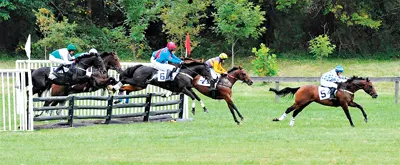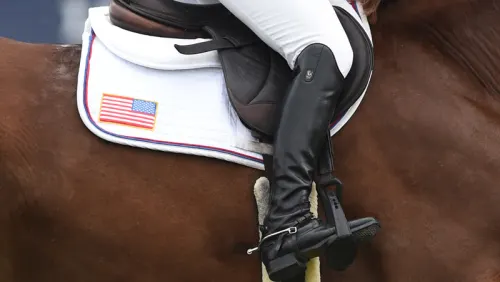A Jockeys’ Guild study, presented at the Jockeys’ Guild Assembly on Jan. 19 in Hollywood, Fla., supports the idea that all helmets involved in an impact should be replaced.
The study was conducted at Chesapeake Testing in Belcamp, Md., and it provided customized testing to mimic a fall on dirt or being stepped on by a horse.
The tests, standardized by ASTM International, involved a monorail drop-tower that plunged a headform onto dirt or a steel equestrian anvil that mimicked the angled edge of a horse’s hoof according to Chesapeake Testing technical operations specialist Bryan Shaffer.
“We drop it and measure the peak Gs, or acceleration, that some accelerometers, or sensors, inside of the helmet read,” explained Shaffer. “Every helmet performs differently, and different ones will have different protection levels on different angles.”
Researchers tested a variety of racing helmets, including Caliente, UOF, LAS, GPA and Charles Owen. The helmets showed less damage upon impact on dirt than steel, though the former proved difficult to reliably replicate in a test setting.
ADVERTISEMENT
Three-dimensional CT scans were taken of the helmets before and after impact. “The helmets, when visually inspected, just looking at them from the outside, look exactly the same; the one that was impacted looks as good as new,” said Shaffer. “But when you scan it, you can actually see that the high-density foam inside the helmet has been compressed. So even though the helmet looked great on the outside, it was compromised.”
The study also found that wearing skullcaps under a helmet may be more protective than wearing a helmet alone. Only one brand of skullcap was tested, but it did significantly reduce G forces at impact during the tests.
The Jockey’s Guild expressed an interest in continuing with this research to better understand helmet manufacturing and to explore possible supplements to helmets, including more types of skullcaps. Future studies could also include safety vest testing.
“They want to be able to make sure that if there is a very severe spill, that the riders are as protected as possible, but at the same time trying to come up with a helmet that is better for low impact as well. And that’s the challenge across really any sports industry right now,” said Shaffer.
The National Steeplechase Foundation had already instituted a helmet-replacement program so that jockeys can apply for reimbursement grants to help cover the price of a new helmet after a fall. The National Steeplechase Association and NSF recommend jockeys take two helmets to races in case one of them is compromised in a fall. The NSF also has supported base-line concussion testing for all licensed jockeys.















